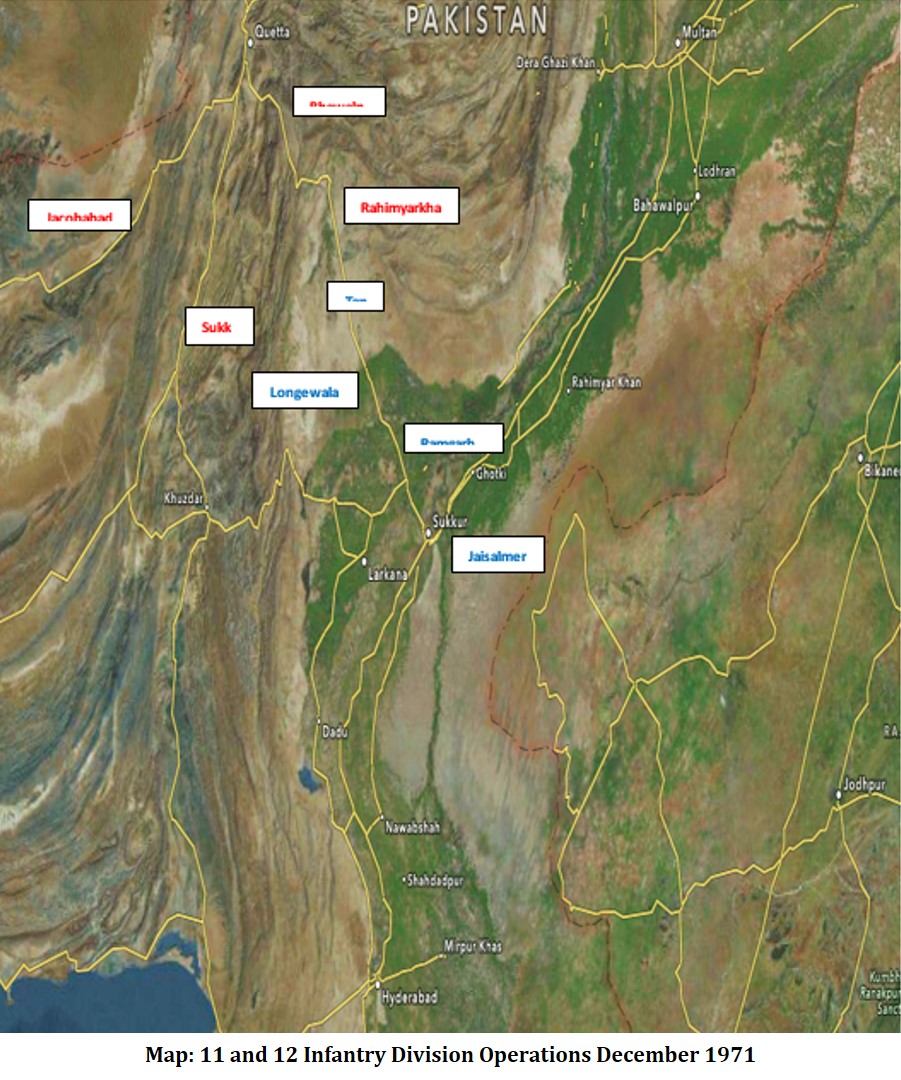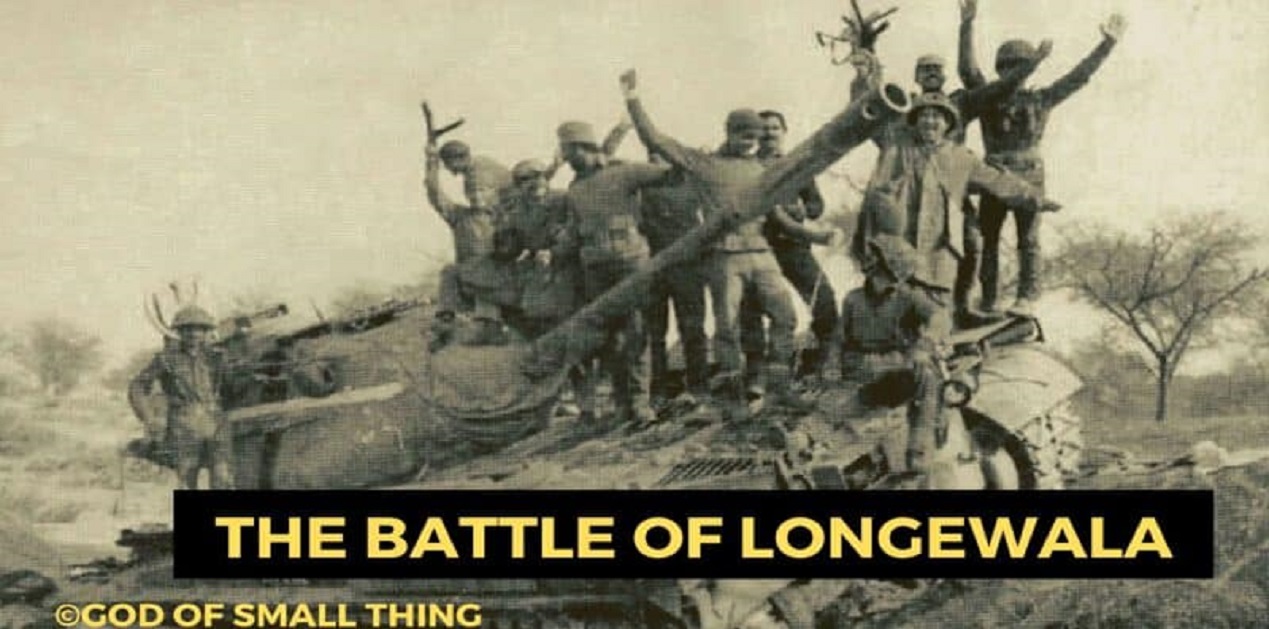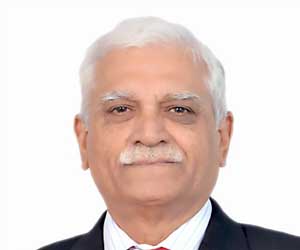Longewala- an Opportunity Lost
On 4 December 1971 when Indian forces were advancing into erstwhile East Pakistan, the Pakistanis decided to advance into Rajasthan along Axis Ramgarh – Jaisalmerand beyond. It was past midnight when sixty odd soldiers in the Longewala Company less a platoon outpost of 23 PUNJAB (in 12 Infantry Division Sector) heard the menacing rumbling of Pakistani tanks. For some unknown reasons the tanks waited close to the post, firing occasional shots or machine gun bursts. The company commander Major Chandpuri held his nerves and was ready to fight back though massively outnumbered and with inadequate firepower to stop this force. These were the leading elements (22 Cavalry followed by 51 Infantry Brigade of Pakistani 18 Infantry Division) of Pakistani offensive force. As the dawn broke Hunters of the Indian Air Force (Fighter Ground Attack aircraft) under Wing Commander MS Bawa got into action. The air attack was so intense and sustained that by the afternoon the Pakistani offensive force (51 Infantry Brigade and 206 Infantry Brigade with 38 Cavalry and 22 Cavalry) [1]was in shock. But Bawa with just four Hunters with him at Jaisalmer kept attacking the force for the next two days. By 6th December 1971 the attacking Pakistani force was in smokes with more than 37 tanks and 40 to 50 vehicles destroyed and in flames[2]
.
After getting their two brigades plus force so badly mauled the Pakistani 18 Infantry Division deployed along Bhawalpur-Rahimayarkhan and Sukkur had nothing to stop any Indian offensive into the Rahimyarkhan or Sukkur. But 12 Infantry Division that was actually tasked to capture Rahimayarkahan and Sukkur -waiting in its assembly area when the Pakistanis reached Longewala did not launch the offensive. The battle of Longewala ended after Wing Commander Bawa’s devastating attack on the hapless Pakistanis.
Applying the ‘What If’ Condition
We will make an attempt here to see what could have possibly happened if this operation was fought synergistically as envisaged in a theatre battle where from the apex strategic leadership to operational and combat leadership all pursue one objective to its logical conclusion. While doing so except for assuming that the forces on that fateful night of 4 December 1971 were part of a Pakistan Centric Unified Theater Command all other resources and terrain conditions would remain the same as these existed in 1971.
First part would be re-capitulation of the events as these actually happened from March to December 1971. Thereafter we will make anassumption that the Indian Armed Forces were reformed and restructured into theatre commands after the 1965 war and the operation of 11 and 12 Infantry Divisions were conducted as part of theatre campaign.
The Actuals: Relevant Aspects of Southern Command Operations in the Thar Desert 1971
During the 1965 Indo-Pak War, Pakistan had made substantial ingress into Indian desert state of Rajasthan causing much embarrassment among the top leadership. Hence in 1971 the Indian leadership had planned offensive in this sector as a pre-emptive move. Two Division sized offensives were to be planned by India’s Southern Command in this sector. The General Officer Commanding in Chief (GOC in C) Southern Command decided offensive along two thrust lines, Barmer- Nayachor/Mirpur by 11 Infantry Division and Tanot-Rahimyar Khan-Sukkur/Bhawalpur by 12 Infantry Division. These thrust lines were 240 kms apart[3].
This operational plan came into being about three years earlier. The GOC- in-C decided to operationalise the same plan in 1971! Before this operational plan could be launched a brigade size force was taken away from Southern Command considering India’s overall goal for decisive victory in the East. In spite of this depletion in his force level the Army Commander stuck to the same offensive plan. Since these thrust lines were separated by about 240 kms there was no flexibility in the plan for switching forces from one thrust line to other. Also 12 Infantry Division lacked the sufficient engineering resources (track material was available for just 60 kms against a requirement of 80 kms) and suitable tanks (the Division had AMX 13 tanks that were no match to T-59 Tanks that the Pakistani forces were expected to use in this sector).
The Army Air Force coordination was quite cumbersome in this theatre. The air effort required by Southern Command (located at Pune) was planned and allotted by Headquarters Western Air Command located at Delhi. The senior air force officer with whom the Army Commander was to deal was Air Officer Commanding at Jodhpur. Control of air effort allotted to Southern Command was under Tactical Air Command (TAC) located at Command Advance HQ. Since the Southern Command formations and units located in Gujarat and Nal (near Bikaner) were not under AOC Jodhpur their air support was coordinated directly with Western Air Command at Delhi[4]. It is surprising that HQ Southern Command did not find it appropriate to rationalize this with the air HQ on the lines Lt Gen JFR Jacob had done with Air Chief Marshall Lal before commencement of hostilities in Eastern Theatre[5].
The 12 Infantry Division Offensive was to commence on 4th December 1971. But the General Officer Commanding of the division postponed the offensive by a day saying that he needed one more day for preparation. However, the Pakistanis did not give that additional day. The leading elements of the Pakistani brigade plus an Armoured Regiment (T 59 tanks) contacted Longewala defences almost five kms inside the Indian territory. The attacking force could have easily run over the Company post had they continued the advance. But the tanks just halted short of the company post – may be for some rest or waiting for their infantry elements to fetch up or both (Rahimyarkhan to Longewala is more than 80 kms in a barren road and track less Thar Desert). The Pakistani offensive was daylighted. Early morning 5 December an Air Observation Post (AOP) air craft flown by an army officer, Major Atma Singh spotted Pakistani armour in front of Longewala defences. The Jaisalmer air base was informed. Wing Commander M S Bawa who was getting impatient for a fight with the Pakistanis, gleefully received this information. He had four functional Hunters at this time. He lost no time in initiating one of the most daring and devastating ground support attack on the Pakistani forces. The Hunters from the base started relentless ‘seek and destroy’ mission on the Pakistani forces. These sorties were conducted almost like an air bridge. With in minutes of a sortie finishing its attack another sortie was over the target. There were times when the Base Commander took great risks in sending single fighter sorties since the other aircraft that was part of this sortie was under intense repairs after it sustained hits from the Pakistani tank’s anti aircraft guns. On another occasion a Pakistani T59 fired at low flying attacking Hunter with its main gun (100 mm calibre). The shell whizzed past the Hunter and momentarily disturbed the aircraft controls. The pilot could barely pull out from the dive scrapping the top of a sand dune. The devastation of Pakistani forces continued throughout the day and even on 6 December 71. Please see map below:

Pakistani forces lost 37 tanks and several soft skinned logistics vehicles. The offensive was decimated by a few brave pilots. The offensive force came to such a pitiable state that they were not in a state of even withdrawing without air support from their own air force. The PAF had refused their army’s request to operationalise the Jacobabad air base to support Pakistani 18 Infantry Division (RYK) operations on the plea that they (PAF) did not get enough notice[6].
Once the plight of the Pakistani offensive was communicated to the Army Chief he wanted immediate pursuit, destruction of the remainder of Pakistani forces in full retreat and capture of the divisional objective at RYK. The Army Commander instead ordered defensive deployment in 12 Infantry Division sector!! At this time 12 Infantry Division was intact in its concentration/assembly areas ready for the planned offensive. The IAF had complete air superiority in tactical battle area right up to the divisional objectives. 11 Infantry Division in the same theatre was making good progress though a few 100 kms away from the 12 Infantry Division planned thrust. The area captured by 11 Infantry Division was a barren peace of desert of no tactical importance to Pakistan. In fact India had to use massive resources to maintain their forces in this area after ceasefire[7].
If it Was a Unified Command Operation- Same Resources, Different Mindset and Reformed Force Structure[8]
Rational Assumptions (What could have been within the limits of reality)
The scenario mentioned hereafter is based on the assumption that required defence forms have been effected (say in 1966 based on lessons learnt from the 1965 War with Pakistan). The Unified Theatre Commands have been created after detailed discussions at the Cabinet Committee on Security (CCS) and a Chief of Defence Staff (CDS) appointed.
11 and 12 Infantry Division Operations as part of Theatre Battles
(An Imaginary Scenario)
On 25 March 1971 the CDS and C-in-C Northwestern Command discussed the operational plan of the theatre in the desert sector. During the discussion it emerged that the thrust lines of earlier plan (made around three years back) to launch offensives along Barmer- Nayachhor and Tanot--Rahimyarkhan-Sukkur/Bhawalpur are separated by 240 kms that precludes flexibility and mutual support. Besides, since the major politico-military objective is liberation of Bangladesh a brigade from 12 Infantry Division will be sent to the Eastern Theatre for the liberation operation. Hence, 11 and 12 Infantry Division offensives must be launched along Ramgarh -Tanot- Sadiqabad- Rahimyarkhan and Sam -Kanoi- Bandha- Ghotadoo (South West of Longewala) - Sukkur axes. The inter-divisional boundary will be Longewala included with 12 Infantry Division. Longewala will be held by a company from 23 PUNJAB of 12 Infantry Division.
Keeping in view the scarcity of troops for operation in the vast desert sector operations of 11 and 12 Infantry Divisions will be supported from three forward airbases at Jaisalmer, Nachana and Kajjuwala. Besides in case these operations achieve success in reaching the green belt during first four days of offensive, additional troops will be inducted from the Khemkaran sector located north of this area. The responsibility to move these forces by rail and road will be that of the Logistics Command. The vintage AMX 13 tanks of these divisions will be replaced by T55 tanks along with adequate maintenance support under arrangement of Logistics Command. The Logistics Command will also equip the forward air bases with adequate maintenance and refueling capacity. Air defence of the entire launch pad as also the thrust lines will be coordinated with the Air Defence Command. The tactical air force headquarters will be co-located with the Theatre HQ and Tactical Air Centers will be located with HQ 12 Infantry Division to coordinate close support, short interdiction and air reconnaissance operations. The air force officers will be part of the operational planning and will be kept fully informed of the tactical situation of the ground operations. The air crew will plan their own air operations after studying the ground battle and keep the respective divisional commanders informed. The entire operation will be conducted with whole hearted coordination, cooperation and interservice cohesion as a team work. All information about the enemy activity (Pakistani 18 Infantry Division) will be shared by the Theatre Command and the air arm on day-to-day basis. Command and control of the battle will be with respective Divisional Commanders along their respective thrust lines. A comprehensive situational awareness of enemy, own, logistics and terrain situation will be built up in conjunction with the air reconnaissance team. This situational awareness will be shared with the Divisional HQ and the Tactical Air Force HQ. Keeping in view the vastness of the Northwestern theatre and importance of air power in this theatre an Air Marshall (equivalent to a three-star general) will coordinate the employment of air power.
The two divisions along with their supporting service elements (tactical air force) reached their respective concentration areas in October 1971. The three designated forward air bases were made operational around this time. India’s external intelligence agency reported sometimes in end November 1971 that the Pakistan Air Force (PAF) has refused to operationalize the Jacobabad air field that could support Pakistan 18 Infantry Division.
On 3 December 1971 Pakistan declared war on India attacking several air fields. 11 and 12 Infantry Divisions were given green signal to operationalize their offensive plans along the two axes at sun set on 4th December 1971. Situational picture built up at the Theatre HQ from air recce, and agents revealed movement of tanks and infantry from Rahimyarkhan towards Indian border ahead of Longewala, Nachana. This information was passed on to HQ 12 Infantry Division and TAC in support of the two divisions. The 12 Infantry Division Commander moved a squadron of tanks in support of the Longewala company post and brigade assembly area at Tanot besides deputing an Engineer Field Company to increase the density of tactical minefield in front of Longewala, Tanot. Commanding Officer 23 PUNJAB of Longewala Company beefed up Longewala with an additional platoon and four anti tanks guns.
Around mid night 4th December 1971 Major Chandpuri of Longewala Company reported that Pakistani tanks have halted close to his defences. He held fire and waited for daylight so that he could direct aimed fire at the tanks. Meanwhile the artillery observation post officer with the post directed medium artillery fire at the enemy troops ahead of Longewala.
As soon as the visibility improved an artillery observation helicopter took off and located enemy tanks ahead of the post. The three air fields were given the general location. Within minutes massive air attacks commenced on the Pakistani offensive formations. By mid day 5th December 1971 more than 40 tanks and 80 vehicles of Pakistan were destroyed. The offensive on Longewala was stalled. The enemy brigades were completely bogged down.
11 Infantry Division launched their offensive as planned on 4th December at dusk. 12 Infantry Division launched offensive along their thrust line just before dusk on 5th December 1971. The tactical air force allotted to these two divisions shifted the attack on Sukkur, Rahimyarkhan and Bhawalpur. The armoured regiments of 11 and 12 Infantry Division isolated Sukkur and Rahimyarkhan respectively on 8th December 71. Meanwhile one brigade along with an armoured regiment were moved from the Khemkaran sector towards Ramgarh. This force reached Ramgarh on night 7th December 1971. On 8th December 1971, 11 and 12 Infantry Divisions attacked Sukkur and Rahimyarkhan. On 11 December 1971 both these objectives were captured. The troops from Khemkaran sector secured the administrative tracks constructed for replenishment of these two divisions in the Objective. The tactical air force commenced attacking Jacobabad air field as there were reports that this air field is being activated at a very fast pace. A number of counter attacks by Pakistan on both these locations were repulsed with synergized application of ground forces with intimate air support. On 14 December 1971 a battalion sized heliborne operation was launched to capture Bhawalpur. On 16 December 1971 as fighting was on around Bhagalpur the Indian forces entered Dacca, a unilateral ceasefire was declared by India. Pakistan agreed to the ceasefire and surrender of its forces in Bangladesh.
Conclusion
Longewala is remembered for the bravery and sheer grit of soldiers and air warriors who fought this unequal battle and came out with flying color- and rightly so. But a bigger question is overlooked in the euphoria of overall victory. What could have been the situation if the Indian forces had fought with complete cohesion and synergy at the top leadership level? Thesame resources, same situation would have given India a much bigger victory. Instead of celebrating defensive battle in own territory we would have celebrated capture of strategic objectives in Pakistan’s green belt. It must also be remembered that the Pakistani offensive was over ambitious; ill equipped, unsupported by their air power in an open desert and was being launched by leaders who were unwilling[10] Thus, India had unique opportunity to capture Sukkur Dam and Rahimyarkhan that control the economy of entire green belt along the Indus Valley in Pakistan.
When we discuss reforms for creating theatre commands there is need to understand what these reforms can achieve rather than getting distracted by issues that are much smaller and at times trivial given the pay offs from these reforms that are overdue since 1950!
End Notes
[1]Bharat Kumar ‘The Battle of Longewala: The Quick Response and Decisive Impact of Air Power’ Defense and Diplomacy October-December 2021 ISSN 2347-3703
[2]Anil Chopra Air Marshall, Shalini Chopra (Edited) ‘The 1971 Indo-Pak Air War Reflections and Projections KW Publishers Private Ltd New Delhi, in association with Centre for Air Power Studies New Delhi 2021, ISBN 9789391490096
[3]Sukhwant Singh Maj Gen, ‘Defense of Western Border Volume Two ‘Vikas Publishing House Pvt Limited 1981, 0706912772
[4]Ibid 3
[5]JFR Jacob Lt Gen, ‘Surrender at Dacca Birth of a Nation’ Manohar Publishers and Distributors New Delhi 1997, reprint 2006 ISBN 817304189X
[6]Ibid 1.
[7]Ibid 3.
[8]Col (Dr.) Rajneesh Singh, ‘CDS and Other Reforms A Midway Milestone’ Center for Strategic Studies and Simulation (CS3) USI Monogram No 1, 2020, New Delhi
[9]Vivek Chadha CDS and Beyond Integration of the Indian Armed Forces KW Publishers Pvt Ltd 2021 Manohar Parrikar Institute of Defence Studies ISBN 978-81-952858-4-6
[10]Ibid 1.
(The paper is the author’s individual scholastic articulation. The author certifies that the article/paper is original in content, unpublished and it has not been submitted for publication/web upload elsewhere, and that the facts and figures quoted are duly referenced, as needed, and are believed to be correct). (The paper does not necessarily represent the organisational stance... More >>
Image Source: https://godofsmallthing.com/myfiles/2020/04/The-Battle-of-Longewala-2-800x445.jpg










Post new comment